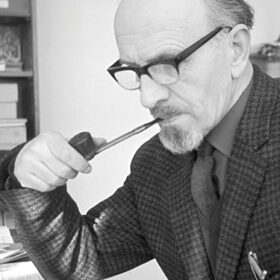Findochty (pronounced Finichty in the Doric) lies on the Moray Firth, a few miles northeast of Buckie. It is a distinctive fishing village, with a large c-shaped harbour lined with whitewashed houses, sheltering in the lea of hill and cliffs behind. The town was served until 1968 by the railway from Aberdeen to Elgin so Fleming is likely to have come on the train when he visited in 1962. He has chosen the viewpoint across the harbour, which dries out at low tide revealing a dark beach, looking at a few boats, the village and church on the hill. Fleming was an acute observer of life and records a few telling details, lending a particular, ordinary humanity to the landscape: there are shadows of children playing, a man and his dog, curtains are drawn, a window open. Findochty is more than a pictorial representation of a fishing village, this is social realism. Perhaps we can hear the Christian song Will your Anchor Hold. Village life in 1962 centred around ship building, religion, football and music and by 1985 much had changed – shipping industry gone, railway closed and a much-reduced population. Fleming’s humanism, concern with the people and history of his kinsfolk, and originality as a composer of a painting were influential in Aberdeen – for example on his younger colleague Robert Henderson Blyth, and more widely as an etcher and watercolourist.

Ian Fleming was born in Glasgow in 1906 and studied at Glasgow School of Art during the 1920s. He began printmaking at art school, where his skill was quickly noticed, with Glasgow Art Gallery purchasing two of his prints while he was still a student. He joined the staff at Glasgow School of Art in 1931 and soon met the Edinburgh-based printmaker William Wilson through their mutual acquaintance Adam Bruce Thomson. Wilson and Fleming struck up an important friendship, sharing views on printmaking technique and subjects, their influence on each other was of mutual benefit to both their practices. During his time at Glasgow School of Art Fleming painted a portrait of the two Roberts – Colquhoun and Macbryde – who were his students at the time (alongside a young Joan Eardley). During the War, Fleming served first as a reserve policeman before joining the Pioneer Corps seeing action in France, the Low Countries and Germany. He left the Army in 1946 as an Acting Major and returned briefly to Glasgow before taking up the position of Warden at Hospitalfield, Arbroath, succeeding the artist, James Cowie. The fishing towns of Angus and Kincardineshire were to be his inspiration for many paintings of this period in which he celebrated the colour, forms and architecture of the working harbour communities. In 1954, he relocated to Aberdeen as Principal of Gray’s School of Art but continued to pursue his painting practice alongside his academic commitments. He was elected a full Academician of the Royal Scottish Academy in 1956, and by the time of his death was the longest-established member. After retiring in 1971, he became one of the founding members of Peacock Printmakers in Aberdeen, alongside Frances Walker.
The Scottish Gallery exhibitions: 1947, 1987